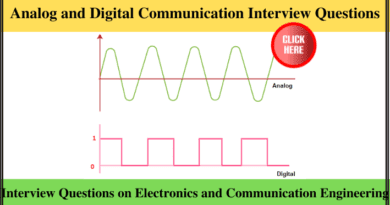Interview Questions on Digital Electronics
Interview Questions on Digital Electronics
Hello guys, In this blog, we will discuss Interview Questions on Digital Electronics(DE) / Digital Logic Design(DLD) / Switching Theory, and Logic Design(STLD). These questions are asked in many technical interviews, Please read all questions. Feel free to ask doubts or suggestions on it
Also read: Interview question on electronic devices and circuits
Interview questions on electronics and communication engineering
How to get a job in ECE Field?
Digital electronics interview questions and answers
What is digital electronics?
Digital electronics is the branch of electronics that deals with the representation of signals, data and information using discrete or binary states (0s and 1s).
What is a digital circuit?
A digital circuit is an electronic circuit that operates on digital signals, as opposed to analog signals.
What is Boolean algebra?
Boolean algebra is a mathematical system that uses binary variables (0s and 1s) to represent logical operations.
What are the advantages of digital circuits over analog circuits?
More reliable and accurate
Easier to store and process data
Less sensitive to noise and interference
More versatile and can be easily adapted to changing requirements
What is a flip-flop?
A flip-flop is a type of circuit that has two stable states and can store binary data.
What are the types of flip-flops?
SR flip-flop
JK flip-flop
D flip-flop
T flip-flop
What is a multiplexer?
A multiplexer (MUX) is a device that selects one of several input signals and forwards the selected input to a single output line.
What is a demultiplexer?
A demultiplexer (DEMUX) is a device that takes a single input signal and routes it to one of several outputs.
What is an encoder?
An encoder is a device that takes an input of multiple binary signals and converts it into a unique output code.
What is a decoder?
A decoder is a device that takes an input code and converts it into the original data in the form of binary signals.
What is a truth table?
A truth table is a table that lists all possible combinations of input values and the corresponding output values for a digital circuit or logic gate.
What is a binary number system?
The binary number system is a base-2 system that uses only two symbols, 0 and 1, to represent numbers.
What is a binary adder?
A binary adder is a digital circuit that performs the addition of binary numbers.
What is a half adder and a full adder?
A half adder is a simple binary adder that performs the addition of two bits and generates a sum and a carry output. A full adder is a binary adder that takes into account any carry from a previous addition and generates both sum and carry outputs.
What is a multiplexer and de-multiplexer?
A multiplexer (MUX) is a device that selects one of several input signals and forwards the selected input to a single output line. A demultiplexer (DEMUX) is a device that takes a single input signal and routes it to one of several outputs.
What is a decoder?
A decoder is a combinational logic circuit that converts a binary code into an equivalent decimal or other output code.
Some More Interview questions:
What is a comparator?
A comparator is a digital circuit that compares two input signals and outputs a logic level based on the relationship between the inputs.
What is a latch and flip-flop?
A latch is a type of circuit that has two stable states and can store binary data. A flip-flop is a type of latch that can change its state only when triggered by an external clock signal.
What is a binary-to-gray code converter and a gray-to-binary code converter?
A binary-to-gray code converter is a circuit that converts a binary number into its equivalent gray code representation. A gray-to-binary code converter is a circuit that converts a gray code representation into its equivalent binary number.
What is a sequential logic circuit?
A sequential logic circuit is a type of digital circuit that uses stored data to determine its output based on the current inputs and previous history.
What is digital electronics and why is it important?
Digital electronics is the branch of electronics that deals with the representation of signals, data, and information using discrete or binary states (0s and 1s). It is important because it allows for the storage, processing, and transfer of data in a reliable and efficient manner.
What are the basic components of a digital circuit?
The basic components of a digital circuit include logic gates, flip-flops, multiplexers, demultiplexers, encoders, decoders, and other combinational and sequential circuits.
What is Boolean algebra and how is it used in digital electronics?
Boolean algebra is a mathematical system that uses binary variables (0s and 1s) to represent logical operations. It is used in digital electronics to simplify the design and analysis of digital circuits.
Other Important Interview Questions on Digital Electronics
What is a flip-flop and what are the different types of flip-flops?
A flip-flop is a type of circuit that has two stable states and can store binary data. The different types of flip-flops include SR, JK, D, and T flip-flops.
What is a multiplexer and how does it work?
A multiplexer (MUX) is a device that selects one of several input signals and forwards the selected input to a single output line. It works by using a control signal to determine which input is to be transmitted to the output.
What is a decoder and how is it used in digital electronics?
A decoder is a combinational logic circuit that converts a binary code into an equivalent decimal or other output code. It is used in digital electronics to convert binary data into a more meaningful representation.
What is a binary adder and how does it work?
A binary adder is a digital circuit that performs the addition of binary numbers. It works by adding two binary numbers bit by bit and generating a sum and carry output for each bit.
What is a latch and how does it differ from a flip-flop?
A latch is a type of circuit that has two stable states and can store binary data. It differs from a flip-flop in that a latch can change its state at any time, while a flip-flop can change its state only when triggered by an external clock signal.
What is a binary-to-gray code converter and why is it used?
A binary-to-gray code converter is a circuit that converts a binary number into its equivalent gray code representation. It is used because gray code is more efficient for certain applications and provides a more unique representation of binary data.
What is a sequential logic circuit and how does it differ from a combinational logic circuit?
A sequential logic circuit is a type of digital circuit that uses stored data to determine its output based on the current inputs and previous history. It differs from a combinational logic circuit in that it has memory and can store data, while a combinational logic circuit only uses the current inputs to determine its output.
For more interesting interview questions, Keep in touch with us, Visit our main website, Digital Tech Facts




